Sawyer Squeeze Water Filter Review
The Sawyer Squeeze is a 3 oz / 85 g hollow-fiber membrane water filter that removes bacteria and protozoa from water. It’s become the default water treatment system for hikers on the Pacific Crest Trail and the Continental Divide Trail and is definitely worth being considered for your backpacking kit.
Despite it now being one of three different filters in the Sawyer lineup. There’s also a Sawyer MINI and the Sawyer Micro – variations on the original Squeeze discussed here. However, the Sawyer Squeeze is probably the only one you should consider for your next backpacking trip (if you’re filtering for one).
The Specs
- Color: Black
- Weight: 3 oz / 85 g
- Filter Medium: Hollow-fiber membrane
- Housing Material: ABS plastic
- Dimensions: 5 x 2 in / 12.7 x 5 cm
- Country of Origin: USA
- MSRP: $37
The Features
- Includes two 32 oz / 950 ml pouches, a cleaning coupling, and accessories for gravity and inline use
- The hollow-fiber membrane filter removes 99.99999% of all bacteria and 99.9999% of all protozoa.
- Filter has a built-in (removable) push/pull cap
- Includes syringe to back-flush (i.e. clean) filter
- Filter fits the threads on most grocery store water bottles (found in the United States)
- Includes mesh carrying case


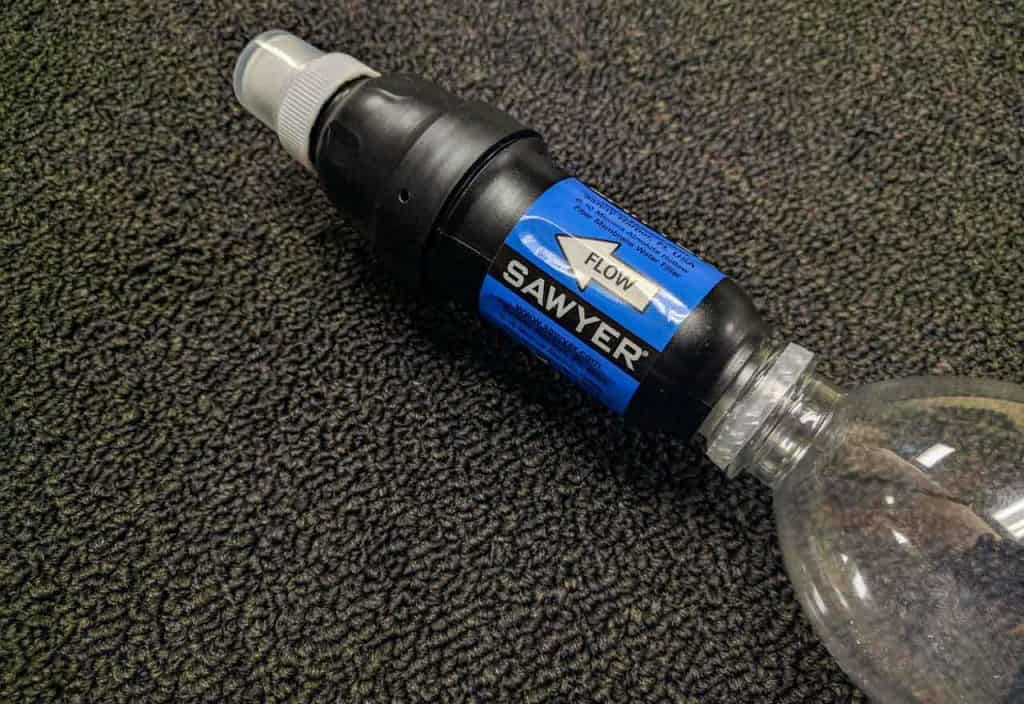
The Good
The Weight
Despite the 3 oz / 85 g Sawyer Squeeze being the heaviest of the three Sawyer Squeeze filters (the Sawyer Micro and the Sawyer MINI weigh in at 2 oz / 57 g) and heavier still than simply carrying bleach or water purification tablets, the Sawyer Squeeze is still a lightweight option for backpacking. It’s also very compact and can be stored directly on a water bottle in the side pocket of your pack.
The Compatibility
Although the Squeeze comes with bags to use for filtering, you also have the option of using a number of store-bought water bottles with the squeeze. Typically, hikers (in the US) will use smartwater or LIFEWTR bottles for this (superb structural integrity, these ones). Even better, get yourself a smartwater or LIFEWTR bottle with a sport cap and then swap out the cap on the Sawyer Squeeze for it (the sport cap keeps dirt off your filter/bottle’s teat).
The Ease of Use
Fill up the bag/bottle, screw on the filter, and squeeze water through the filter. It’s not complicated at all. Just remember that if you connect the Sawyer Squeeze to a water bottle, it is considered dirty water (i.e., it has been contaminated) until you have cleaned the bottle with chemicals.



The Okay
The Flow Rate
The flow rate on the Sawyer Squeeze isn’t terrible, but the flow rate you have when you first get one won’t last long. Sure, you can backflush it (more on that below), but after filtering some sediment-heavy water, the flow rate will never be what it was when you first got it.
The Backflushing
Included with the Squeeze is a syringe for backflushing (i.e. cleaning). You fill the syringe with clean water and then push that water backward through the Squeeze to backflush. This can be annoying to do in the backcountry, and even at home, you can never really seem to restore your Sawyer to what it was when you first got it. All it does is serve to slow your Squeeze’s descent into uselessness.
The O-Ring
Inside the bottom of the Squeeze (where you screw it onto your Sawyer bag or water bottle) is a removable o-ring to ensure a smooth transfer of water from your dirty water container and through the Squeeze. The threads on the Sawyer are shallower than the threads on most water bottles, so you must be careful not to overtighten the Sawyer, or you will damage this o-ring, and your filter won’t work as well. I have also had problems with this o-ring falling out when removing the Sawyer from my bottles. It can be replaced with rubber gaskets from hardware stores, but make sure you get one that’s FDA-approved for food use (or just risk having toxins in your water).



The Bad
The Freezing
One of the worst things about the Sawyer Squeeze is that, due to it using a hollow fiber membrane to filter, it can freeze. What happens if it freezes? It no longer functions as a reliable water filter. When the filter is left in freezing temperatures, residual water trapped inside freezes and expands, thus damaging the membrane. There is no way to tell if your filter has been damaged due to freezing. Sawyer’s official position on freezing? “THERE IS NO WARRANTY FOR A FROZEN FILTER.”
The Bags
Sawyer includes two 32 fl. oz. pouches (better known as bags) with the Squeeze filters. You’re supposed to fill these bags with water, screw the filter onto the top of the bag, and then squeeze (get it? squeeze?) the water through the filter from the pouch. It works fine. The only problem is that these pouches aren’t incredibly robust, and they will break with repeated use. Many long-distance hikers use water bottles instead of pouches which work well except that you will have to stop to let more air into the bottle while filtering.


Who is it for?
Beginner Backpackers: If you’re getting into backpacking, there’s nothing wrong with getting yourself a Sawyer Squeeze. If you’re looking at getting something like a Lifestraw (which probably does a better job of marketing to beginner backpackers), you might as well get yourself a Sawyer Squeeze.
Weekend Warriors: If you’re filtering for just yourself on your weekend backpacking trips (more on this below), then the Sawyer Squeeze is a great option – so long as you don’t have to worry about viruses in your water supply.
Thru-Hikers: The Sawyer Squeeze is basically part of the default thru-hiker kit. If you’re heading out on a thru-hike and don’t know what you want to bring regarding water treatment, the Squeeze is as safe a bet as possible.
A Note for Couples: If you are a couple on a hike and will be filtering a lot of water, I suggest bringing one Sawyer Squeeze for each of you. It would be incredibly frustrating to sit and filter something like eight liters of water with a single Squeeze. You might even want to consider something heavier (but more convenient), like a Platypus GravityWorks.
Most-popular Alternatives
| Water Treatment | Price | Weight | Type | Dimensions | Medium | Removes |
|---|---|---|---|---|---|---|
| Sawyer Micro | $29 | 2 oz / 57 g | Squeeze/Straw | 2 x 5 in / 5 x 13 cm | Hollow fiber | Protozoa and bacteria |
| Sawyer Mini | $20 | 2 oz / 57 g | Squeeze/Straw | 1 x 5 in / 2.5 x 6.6 cm | Hollow fiber | Protozoa and bacteria |
| Katadyn BeFree | $25 | 2.3 oz / 65 g | Bottle | 11.3 x 3.5 x 2.8 in / 29 x 9 x 7 cm | Hollow fiber | Protozoa and bacteria |
| Aquamira | $15 | 3 oz / 85 g | Drops | N/A | Chlorine dioxide | Protozoa, bacteria, and viruses |
| Platypus GravityWorks | $100 | 10.9 oz / 309 g | Gravity | 3 x 7.4 in / 7.6 x 18.8 cm | Hollow fiber | Protozoa and bacteria |
Conclusion
The Sawyer Squeeze isn’t the perfect water filter, but it’s arguably the best one currently available for backpacking if you filter just for yourself.
If you’re going to be on a long-distance thru-hike, this is probably your best option if you’re not somewhere you need to treat for viruses and you’re not a fan of using chemicals to treat your water. That said, it is also a great and inexpensive option if you’re getting into backpacking or you’re just out for the occasional weekend trip.
Check out the Sawyer Squeeze here.
Affiliate Disclosure: This page may contain affiliate links, which means I may receive small commissions for purchases made via these links at no additional cost to you. This helps pay the bills and keep the site up and running. Thank you for your support!
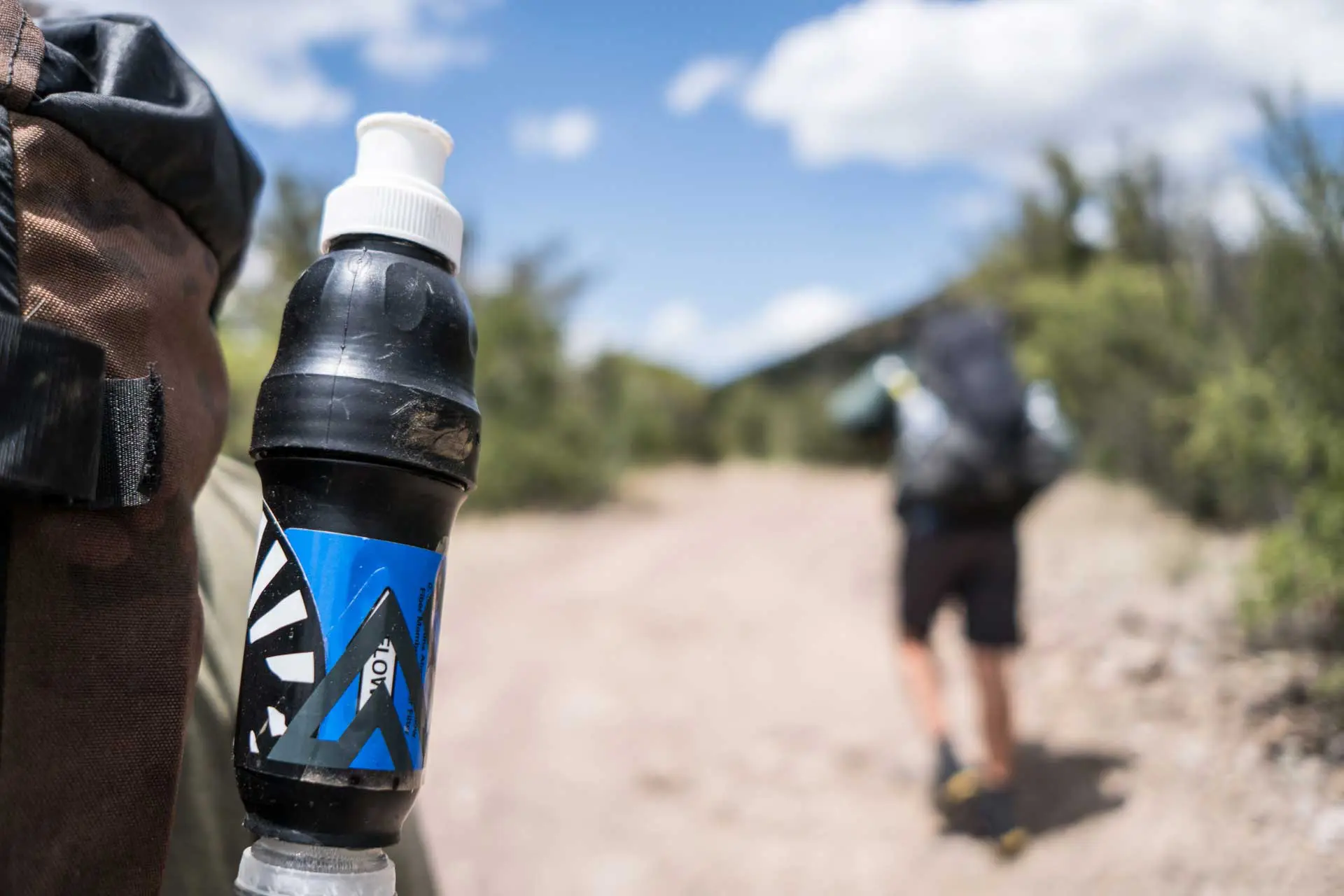

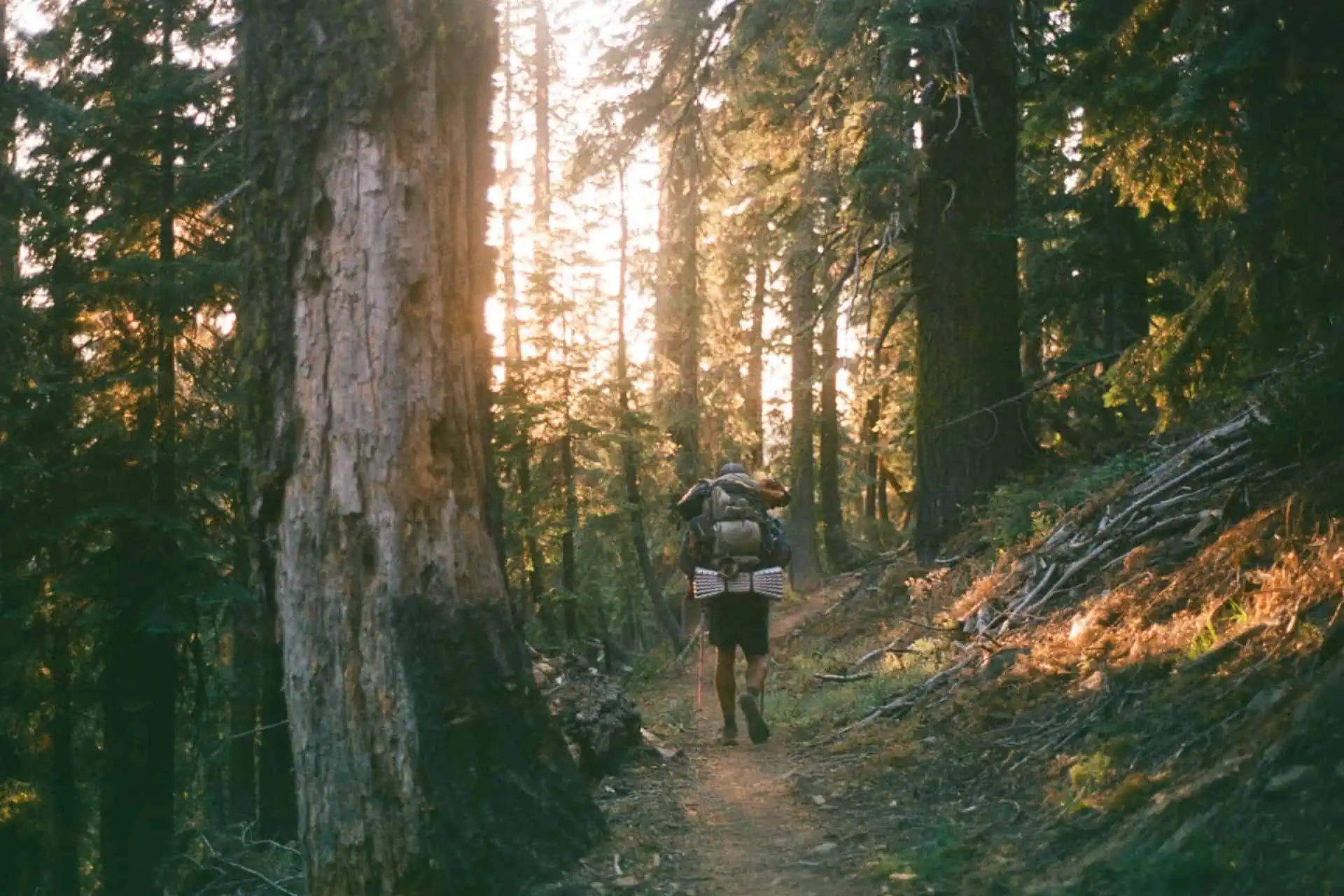

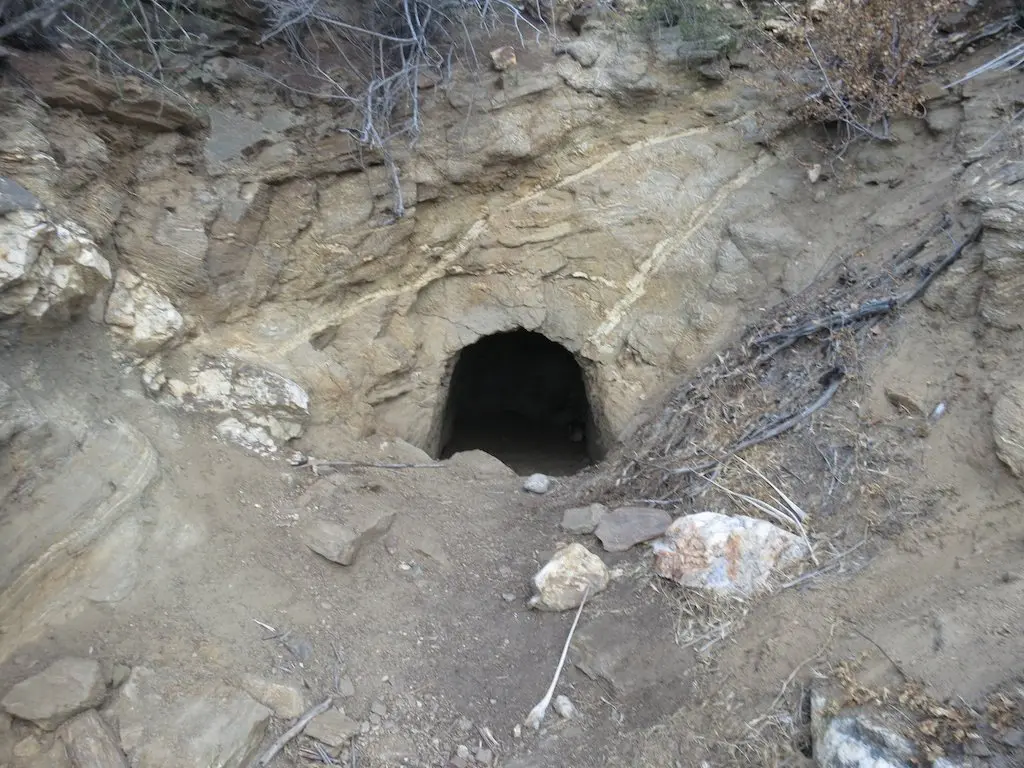

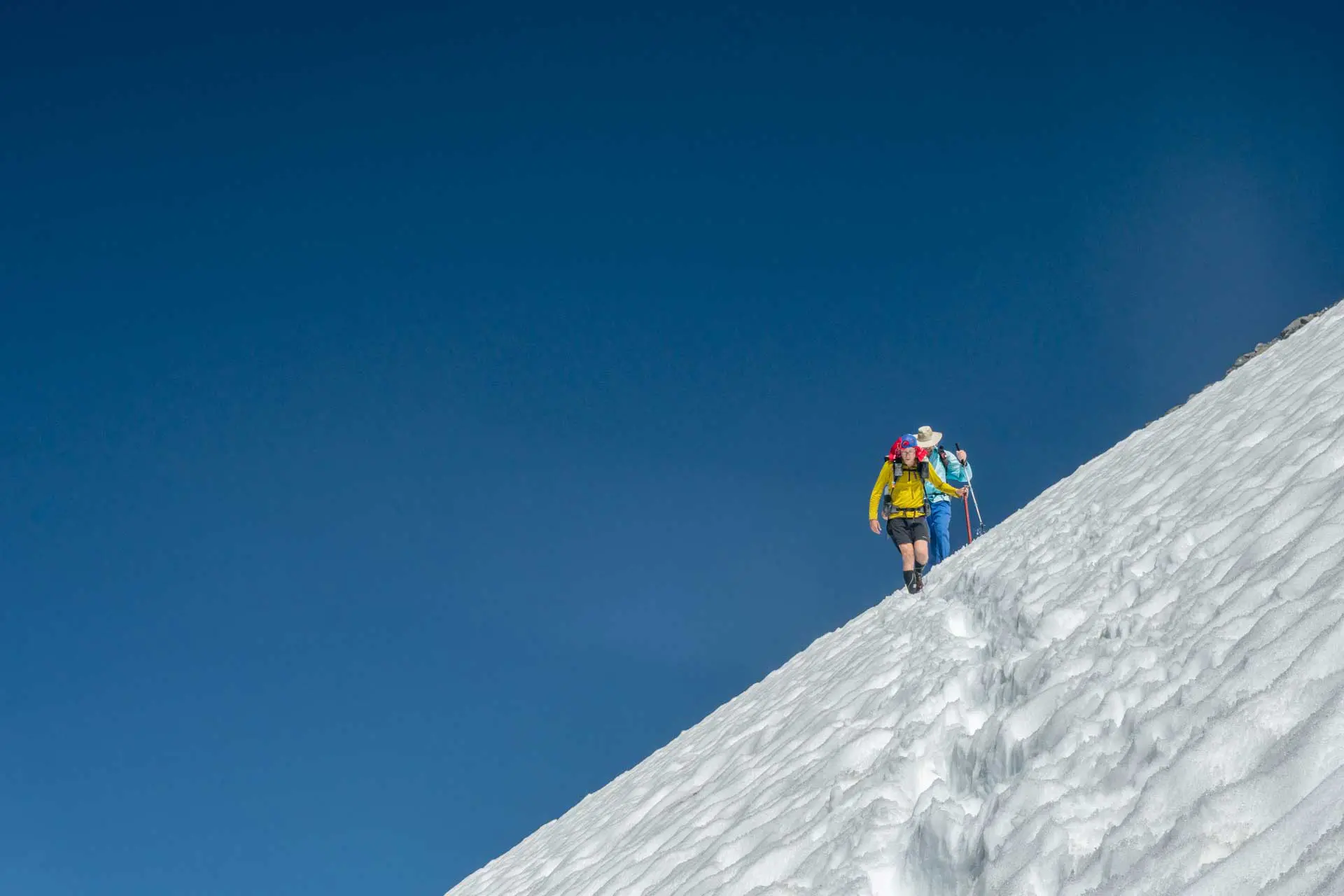
Should be noted that the Smartwater sports cap can fit onto the Sawyer’s outflow spout to backflush with a Smartwater bottle (but also keep in mind that with smart water source choice, when available, I never backflushed my filter once on my AT thru-hike, albeit the flow was very slow towards the end). I also suggest going to Home Depot and getting a garden hose gasket (the brown ones), they are much more durable than the stock gasket and you’ll have a few extras just in case or in my case to hand out to other thru-hikers.
I’d also suggest always, always, always going with the Squeeze over the mini or micro because, as far as the mini goes, the flow rate is so pathetic (and will get worse with use) that it’s worth the extra ounces/dollars for the full sized version. I thought I was being clever using a mini but found myself replacing it with a Squeeze as soon as I could on the AT at Neels Gap (aka within 4 days of start).
100% agree with all of this – excellent advice!
One other thing – the Sawyer does not filter out taste (sounds obvious but I want to point that out). I always try to filter running water (stream, river, etc.) but sometimes am forced to filter water from a lake. In late summer, lakes can become shallow, resulting in more algae. The filtered water tastes like the algae even though it’s safe to drink. I add Mio water flavoring to mask the algae taste. The Sawyer is still an awesome product!
Mio + True Lemon packets is an excellent mix if you haven’t tried it.
Thanks for the tip! Is there a particular flavor of Mio you recommend? I will definitely have to try this.
I usually just get whichever Mio is available with electrolytes in it.
I have not seen the Micro version but based on my experience, the Squeeze is better than the Mini – the Mini is not that much smaller or lighter but the flow rate is much slower. To prevent freezing, put the filter in your sleeping bag with you at night. I haven’t had an issue with the o-ring but I wonder if you wrote to Sawyer if they would sell you or possibly send you a free replacement ring? Once piece of advice – as with all gear, test it before you go on a trip to make sure it still is functioning . It takes longer to filter the water the first time you use it after you take it out of storage. The only drawback to these filters is they came become clogged. Overall, it’s still the best filter on the market.
Another great review – thanks, Mac!
It’s a 1inch washer as used for standard 1 inch garden hoses. You can get a useable replacement from any hardware store. As I mentioned, I like the kind that has a built in mesh filter and Camco makes them for RV drinking water hoses.
Another con is that to work it requires that washer/O-ring between the dirty water bag and the filter which is easily lost particularly when backflushing. Make sure to bring a spare!
I use a Camco 20183 1″ Hose Filter Washer which keeps larger particles out of the filter. I like it because it is made for drinkable water but it doesn’t have the retaining tabs and is black so is more easily lost which is annoying. This seemed to help retain the flow by quite a bit comparing two filters used with the same sources.
While you can backflush with a smart water bottle I found using the syringe to be much more effective. It requires some strong consistent pressure. Shaking the filter with the dirty side down also helps loosen larger particles. For a thru hike I would suggest trying to backflush with a smart water bottle every time you collect water and backflushing with the syringe in town as a matter of routine but then I’m not a thru hiker.
Depending on the problem you can apparently improve the flow by soaking the filter in a warm vinegar solution a few times (see instructions). This dissolves some of the calcium buildup. I have not tried it although we do this with our glass electric kettle and it does work there.
Also probably a good idea to occasionally soak the filter in a chlorine dioxide solution (eg Aqua Mira) to kill anything in the filter.
We used two of these between three of us on various Sierra trips, setup to gravity feed from 2L CNOC vecto water collection bags.
The syringe definitely works better, but the sport cap does a very good job. And yes, shaking it/tapping it on a rock also does wonders to shake loose anything missed in the first (couple) of flushes.
I haven’t tried the warm vinegar solution, but I guess it’s worth a shot!